A few years ago I was given the chance to visit the Third Street Cottages on Whidbey Island and the opening of the Greenwood Avenue Cottages in Seattle. These communities, by renowned architect Ross Chapin and developer Jim Soules, have become famous for being small, sustainable and community oriented. Chapin calls them pocket neighborhoods.
I think my first exposure to small and tiny houses was Chapin’s Third Street Cottages, which were featured in Sarah Susanka’s book, Creating the Not So Big House. They were so well designed and so space efficient and sufficient that it has not occurred to me since that I would need anything bigger. The Third Street Cottages are about 600-650 square feet and have a great room with living, cooking and dining areas, a downstairs bathroom with laundry facilities and a downstairs bedroom. Each house also has a full size loft that is accessed by a ship’s ladder. The owners personalize each cottage by naming their homes. I visited a cottage in the Third Street community named Plum Corner for the plum trees that were left behind during construction.
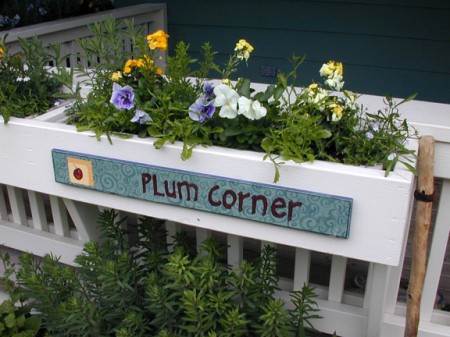
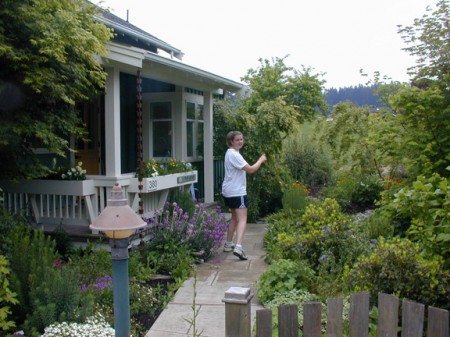
The typical cottage community by Chapin includes 8 cottages on a 2/3 acre plot that usually holds one or two larger homes. The cottages surround a “green” area that holds seating, grass and trees and a place to grow community vegetables. A parking lot is off to the side of each community, hidden from view by a fence or bushes. Each cottage has its own small garden area surrounded by a low fence and each community has a shared tool shed and meeting room. Each small house is sold as a condominium and a monthly fee helps to maintain the garden and outlying areas.
To create a balance between the public and private areas, Chapin uses the concept of “layering”. The entryway into the main garden is the first layer, moving from public to more private. Anyone who does not belong in this area is noticed right away from each of the cottages. This way, neighbors can keep an eye on each other’s homes. The layering concept continues with the main garden area leading into the more private cottage gardens through the small fences and then each house is entered by first going up several stairs to the open front porches. The porches bring to mind the charming bungalows of the Arts & Crafts movement of the early 1900’s. The porches extend the living area of the small homes as well as offering a convenient area for neighborly chats.
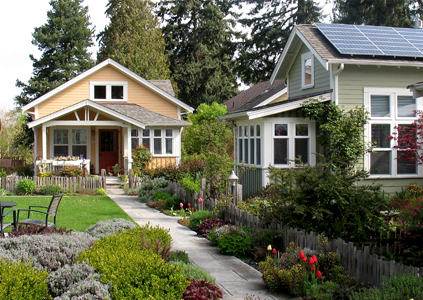
I was able to view the Greenwood Avenue cottages during an open house tour and I was impressed by how the little details in the homes gave them each a different personality. Each tiny home uses architectural tricks to create a larger space: built-in bookshelves, alcoves, delineated ceiling heights between living and eating areas, ample windows and skylights. Each home is personalized with special details such as trim, woodwork (the walls of the Third Street Cottages are paneled in reclaimed spruce saved from destruction by a piano company) and cubby areas holding shelves, window seats or dining nooks.
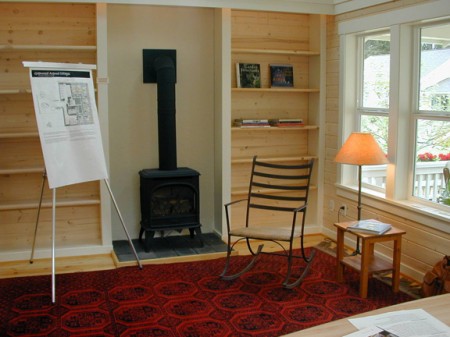

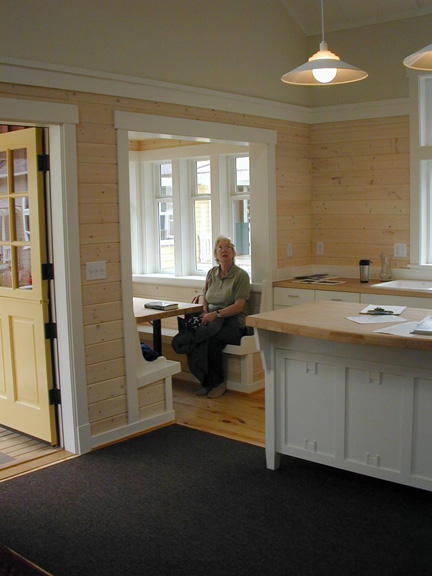
Chapin believes in not only designing and building to save space and money, but to promote sustainability. The low garden fences are recycled fencing, the cottage’s siding is cement fiber board rather than wood, and the garden pathways were laid with crushed hazelnut shells from a local nut company.
Ross Chapin Architects also sell cottage home and small home plans. The three smallest are the Blue Sky Cabin at 307 square ft. the Backyard Cottage at 449 square ft. and the Lizzie Cottage at 540 square ft.
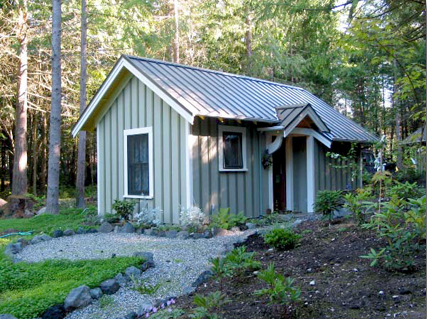
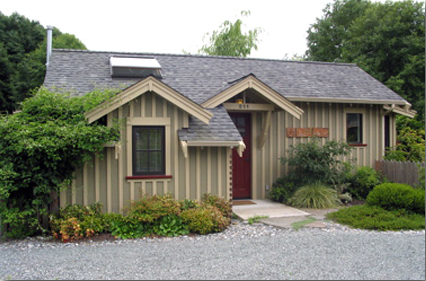
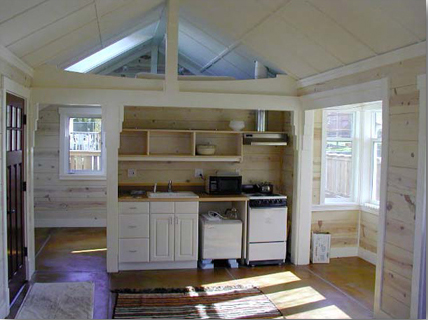
Living small — Some Utahns discovering the charm of cottages
Cottage Housing in Your Community (PDF)
A guide to drafting a cottage housing ordinance
Tiny House Village Concept post on Tiny House Design
If you enjoyed this post, subscribe to our feed
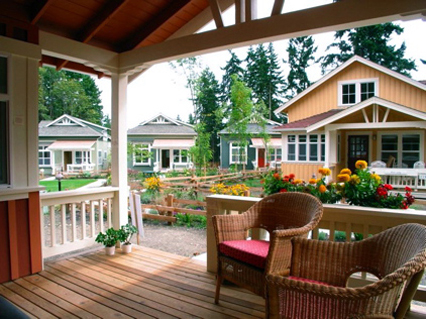
How utterly charming. I have never considered leaving the east coast until reading about this tiny house village. Is there a move in my future? I thought I already owned my dream house. Why am I still dreaming?
http://contentinacottage.blogspot.com
We need about twice the sf for us, but this is a great concept and we need to buy some land here in NC or in SC and build a small community like this.
Ms. Marva, I was just telling my husband that all the cool places are on the west coast. I’d love to find a place like this close by to visit.
You just need to do some research so that you can get yourself the best quality product for the cheapest price possible. When you are shopping online, you have the benefit of comparing prices quickly so that you can choose the best dryers at the best price available.
Beautiful–but how much are they?
How much does a one bedroom with loft cost, and are there any communities with available housing???
Hi Questioner,
The pocket communities are pretty expensive. When I was at the Third Street Cottages, they were being sold for around $150,000-$200,000. That went up after a few years. The Greenwood Avenue cottage were selling for about $350,000 to $400,000 when I was there.
The plans for the cottages are priced between $750-$950.
Hi all,
Thanks for your interest in our innovative new communities we’ve been pioneering here in the Pacific NW since 1998. Regarding prices – land is very expensive here in the PNW compared to any other place in the U.S. Thus, new homes (of any size, small or large) are expensive given the land values. For instance, in the Kirkland/Redmond area close in to Microsoft world headquarters and our technology employers, a single, 7200 SF lot sells for $350,000.00 That’s just the raw land before permits, utilities, improvements, or any structure is constructed. This is important to remember as you try to compare prices here vs. other parts of the U.S. The typical new home of about 2500 – 3000 SF sells for about $1M. This is nothing fancy, just a basic new house in a close in neighborhood close to jobs and transit.
Price appreciation continues in this area as there aren’t enough houses to meet our strong jobs growth in the region. Prices in our existing communities have risen since Christina visited. We built Third Street Cottages ten years ago, Greenwood Avenue Cottages six years ago. Prices have risen in that timeframe a good bit.
Thanks Linda!
Yes, I remember when I first saw the Third Street Cottage prices, how affordable they were at about $150,000. That changed very quickly during the housing boom. I also think that these communities became so popular that the prices rose to meet that popularity. Have you seen a continuing and even a rising interest in smaller homes?
You did a wonderful job on this topic! Also since writing this article, Chapin has published a book on these neighborhoods.
Pocket Neighborhoods, Creating Small-scale Community in A Large-scale World
by Chapin, Ross (Book – 2011)
307.3362 CHA(Library Code)
Average Rating: 4+STARS
I really enjoyed the book–especially the comments by the residents.
Content in a Cottage.
Your blog is lovely!
Smaller, higher quality new homes in the context of a real community and lush gardens continue to be highly desired, in our experience, and is growing in interest. Our homes are also BuiltGreen and Energy Star Certified, which has strong interest as well.
Price appreciation of both our homes, and other homes in our region continues because of our strong economy and job growth. Folks continue to move to our area from other parts of the U.S. As our homes are well-located within employment centers, close to transit and amenities – these locations are highly desired.
Keep checking our web site for the rare resale in our completed communities as well as announcements of our next projects. http://www.cottagecompany.com
Thanks!
I have admired the work of the Cottage Company and Ross Chapin for some years now.
In 2003, on a trip from Vancouver, BC to Seattle I made a point of stopping in at an open house of the Conover Commons Cottages.
Photos do not do justice to the Cottage Company’s masterful execution of the designs. I can’t speak highly enough of Ross Chapin’s thoughtfulness and thorough use of space. These homes appear to be constructed by craftsman not construction workers and the end results are proof of this.
Keep up the great work Linda. You are helping to restore the true meaning of Home.
there is not much thoughtfulness when charging the amount money the company does for one of these little houses…What about the homeless and strudling families who could use a simple small like these for shelter and humanity to not have to travel from shelter to shelter, and instead giving them a small community to have a small community farm for food and resource to feed themselves and training to know hoe to do so. Instead they are like many other bright ideas, lets market a great concept and as soon as people catch on lets charge them out the ying yang to have any of it. so they get rich while more and more people become homeless..Yeah real thoughtful
Tiffany, this is a business. It is not government funded. You bringing up the homeless or struggling family is not even remotely close or in the vicinity of this discussion. This company did not create the desirability of the area because of job prospects, being close to amenities, beautiful views, etc. It they are building in these areas, they are not exempt from paying the high prices for the land, permits, etc. They had to pay for those, they are not free and if the house values went up, the homeowners are the ones who reap the benefit, not the builders.
Are other communities planned for Oregon?
The properties are great and the use of space is something i really admire but the price is a little ridiculous and totally against all the philosophies of true small-space living. Small space living is about affordability in an unstable economy and downsizing for a sense of personal peace. This is sort of poser-ish.. but the idea is essentially very good.
Any chance of building these communities in New England??? These tiny cottages are exactly the type of house I’d love to buy for my first home!
JhSpain Builders- Concord,NH
Hi Lauren. You may want to contact Ross Chapin or the Cottage Company on their future plans. You can purchase home plans from them if you are interested in building your own home.
Greater ecology, spaciousness and efficiency:
Vaulted ceilings create a cold home, because heat rises.
Lofts may be impractical with age or injury.
Replace books and entertainment centers with a handheld computer.
Rather than an end table and table lamp, try a floor lamp.
Cover the clutter of a kitchenette with louver doors.
Rather than kitchen drawers, try open shelving and pull-out baskets – they’re portable.
Try a standard-sized, single-bowl kitchen sink.
Try an under-counter, combination washer/dryer.
A fridge will use more energy if it is adjacent to a stove.
For extra counter space, place a microwave on a shelf.
Rather than a bathroom vanity, store towels and cosmetic baskets on open, narrow shelving over a toilet.
While sitting on a bench in a tub, try a handheld shower nozzle.
Rather than curtains, try a small knick knack shelf over a window.
Wall-to-wall carpeting is unhealthy.
Try throw rugs that can be easily cleaned in a washing machine.
Create an exterior wood door near a wood stove – to grab wood as needed.
I am looking for a retirement community that features small houses as an option for persons who want to live independently, but would like to be part of a community. Can’t find anybody in the Triangle Area of North Carolina who knows what I’m talking about. Can you make a suggestion?
Flo, just read your question and I myself am looking for a small house in a community and happened upon The Cottages at Holly Ridge in N.C. Maybe this is something you might be interested. I myself am trying to sell a rather large house in this economy so I can move also. Wish me luck!
Good luck sherri!!
These beautiful cottages within Mr. Chapin’s “pocket neighborhoods” are the true meaning of “home.” The very designs of these entire sies neihborhoods promotes every family’s sense of well-being and security that has been lost among our blocks and blocks of row houses. Who among us wouldn’t love to raise our families within these communities where you can chat with your nearest neighbor while restfully sitting in your wicker chair on the front porch? Not to mention the peacefullness you feel knowing that your children are running, jumping, and playing within the safe confines of the central “green area.”
For me, that would be total bliss. But alas, I’m a disabled, single mother of one and none of these cottages are within my budget. Perhaps Mr.Chapin would consider several small communities outside of the higher taxable neiborhoods, using cheaper materials, but still incorporating the same elements that make these pocket neighborhoods so very, very charming.
Rena K. .
For those in the greater Seattle or Puget Sound area, please come visit our newest ‘pocket neighborhood’ community – Chico Beach Cottages – seven 2 or 3 bedroom homes on waterfront, with sweeping views of Mt. Rainier and Puget Sounds. Prices range from $369,950 which is VERY affordable for the Pacific Northwest!
affordability is our responsibilitie …… be cause the more we save the more we can do… and the more we can hel[p one another and then the happier we can all be …. <3
Gorgeous. Wish many more homes were grouped like this! Seems so much more human…
Nice job Ross.
Where is your community idea? Also looking for someone interested in sharing a tiny house part of the year in beautiful, pristine area near Lake Huron in Ontario Canada. Have 148 acres. Anyone interested in the building of a small house?
For those who have been fans of our Third Street Cottages community on Whidbey Island, please know that one of the homes is available for sale! For more info, please see: http://www.cottagecompany.com/for-sale/listing-detail.aspx?lid=28
Call or email for an appointment to see this special home and community!
The astronomical cost of these homes in these tiny communities is very disappointing and unaffordable by most these days. Defeats the purpose of sustainable living. Oh well, another great concept ruined by capitalisim. Just seems to be a huge, no pun intended, conflict of interest in living small and eco-friendly.
ABSOLUTELY RIGHT! These are yuppie-fied versions of small housing. This is sadly the near-future of the small house movement. Zoning issues prevent the building of many small permanent homes anyplace a private individual can afford to build them. The only place tiny houses will flourish is on land too large for an individual to afford, thus some rich exploitative developers will build them on top of one another and charge as much (or more) than a home twice the size!!!
Pocket communities at this cost are a cancer to the market no matter what happens. If they take off, the small house movement has been hijacked by profitmongers and you’ll have to sacrifice all the comfort of conventional housing without saving ANY MONEY WHATSOEVER. If they DON’T sell, the nation will be punished for having the common sense to reject this scam, because the banks will lose all kinds of money in these communities and our beloved politicians will just take the money we refused to give them for a crap product in the form of another bailout.
If more than a small handful of these things are built, its a lose-lose situation.
I agree these prices are absurd. It completely defeats the original intent on micro homes. But if they want to bulid them and they get zoning then let them. Because if they are able to do it it will be hard for officials to say yes to their concept and no to a project that truly is affordable housing concept. Let them open the door.
In my area there are a lot of mobile home parks. It seems it would fall in the very same code. Maybe even acquire a mobile home park and use its current infrastructure would be the easiest, ie electric, water and sewer. I have been living in under 200sq for over a decade. Its a sailboat. But the concept is the same and there could be many similar issues that could help the micro home issues, such as blackwater holding tanks that either have a pumpout hook-up or a mobile pumpout, this is how the marinas work. There is even federal grants that pay for these at marinas. Getting away from the mobile home park image to more of a marina type eco green garden type I think would be welcomed in communities.
Let me begin by saying the tiny house movement is beautiful, nature preserving and wonderful for our environment. I am actual sick of watching all these shows on rich sprawling spaces for even just one person to live which is just ridiculous. However, this country is riddled with homeless people and homeless families, why cant the government, private groups, and these rich people who love to flaunt there charity involvements build tiny home communities for homeless and struggling people to live in. Any one of them would be elated to have a small little house even as small as 80 sq ft to live in. They can also be taught to garden for food and work in and for their little community. Homeschooling for their children and for safety, police can run background checks and their can be sometime of process to qualify. But building these communities and charging 150,000 and up for such a house is preposterous.
I agree that $150,000 for such little sf is way too much, but would it be that much in a southeastern state where it is usually less expensive to live?
And I am sick of people assuming that when people are well off from hard work (NOT THE 1%) that it should be required that they put their hard earned money to work to build houses for homeless people who many chose to live that way and now they are also expected to pay to teach these people how to garden, home school their children? Where is the personal responsibility. If social programs like these were to exist, don’t just let the well off people pay for it, let everyone pay for it based on percentage of what they make. If you are going to punish people from being successful then what is the sense for people to try to succeed so they can have a dream house when people such as yourself will only look down at them and assume that they are beneath you just because they live in a large house. Get over yourself! Where is the incentive to strike out on your own when your hard-earned money will be expected to bail the rest of the people who are content to “just be”. I love tiny houses, but I dislike people who like them as well but take it upon themselves to look down on others for not wanting to live like them.
The pricing is very disappointing… and at odds with the concept. That said… the Greenwood cottages and porches could not be more perfect visually and vibe-wise for me… I only wish So Cal would update their zoning laws, rip out countless ugly, soul-less apartment buildings and replace with these types of communities. Such amazing potential. Also… could give back the dream of home ownership to so many… but I think they can be beautiful in a good area… and under 200k.
Writing from Vancouver, BC, where seeing the price tag from these houses was a shock – IN A GOOD WAY! So many of the commenters here do not seem to realize the cost of living on the west coast. Vancouver BC is now ranked the second most unaffordable city in the world to live in – right behind Hong Kong. (perhaps some readers here will find this report at http://www.demographia.com/dhi.pdf an eye-opener and realise that to many, 150k for a small livable, wonderful home is an amazing dream). How wonderful these homes look to me, a mom of two small children who really doesn’t desire or need more then one of these small Third st cottages to make a wonderful home. To me, a price tag of 150k is a fantasy if I want to stay in (or near) the city I love and grew up in. Not everyone lives (or can, or wants to) live in the midwest US. Keep that in mind!
We are pushing for this type of small, sustainable and highly energy efficient housing. We have proven that such a home can be built for less than $5K and fully finished for about $25K. We build with SIPs exclusively and we want to introduce smaller homes to the ‘working poor’ who can barely afford rent in Alberta (starting at $1,500/month and UP). With land, we can easily price these well under $100K.
I wish these houses were in Oregon City and all over. The prices for homes here are way over rated. Some
are tear downs and they still want over $300,000. Some of us would buy in a heartbeat if there were
something like these. I think this is a great idea!